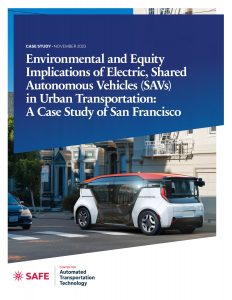Environmental and Equity Implications of Electric, Shared Autonomous Vehicles (SAVs) in Urban Transportation: A Case Study of San Francisco
Allanté V. Whitmore, Ph.D.
November 2023
High levels of air and noise pollution are a fact of life for many people living and commuting in urban areas, but these problems are more than just an inconvenience for city dwellers—they’re a major social justice issue. Lower income populations and communities of color are disproportionately burdened by the air and noise pollution caused by society’s overreliance of single-occupancy personal vehicles. This case study unpacks how the broader adoption of electric, Shared Autonomous Vehicles (SAVs) can improve air quality and reduce noise pollution for neighborhoods across a city, and especially in disadvantaged communities.
- 40% decrease in fine particulate matter (PM2.5) concentrations
- 61% decrease in noise polluting vehicle trips
- The greatest reductions in air and noise pollution will occur in low-income neighborhoods and communities of color.
This research builds on SAFE’s long-standing transportation work and aligns with ReMo’s mission, showing how widespread deployment of AVs can provide a safe, affordable, accessible, and sustainable mobility option while making the transportation system more resilient.
Download a summary of the case study here.

